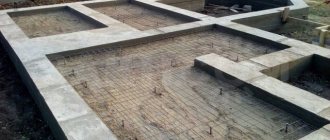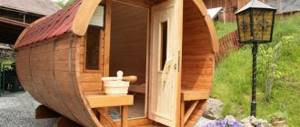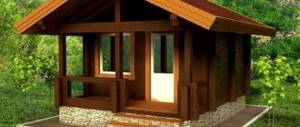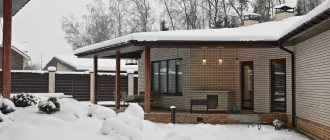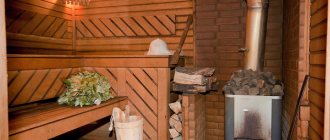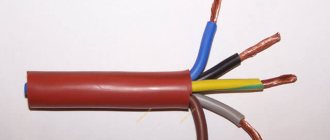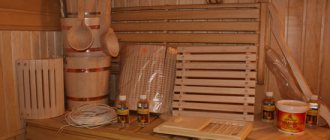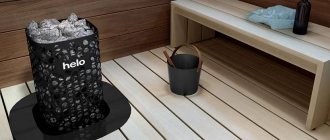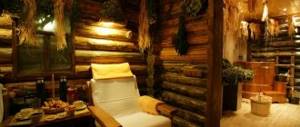How and by what parameters to choose
Deciding on the project
As I wrote above, I would like a bathhouse with an attic. This is the first requirement. Initially, I planned to build a bathhouse with a 6x6 attic. But due to the requirement to build structures on the site no closer than 3 meters to the fence, such a bathhouse size would leave little space on the site (I also have a house, a garage, garden beds and a playground). However, in contrast to this I would like to have in the bath:
- spacious lounge
spacious attic
- separate shower room
- steam room
- separate hallway
Choosing a foundation
It all depends on the soil and the weight of the structure. For most soils and buildings, the choice of a shallow strip foundation made of monolithic reinforced concrete will be universal. It is also possible to choose the most reliable slab reinforced concrete foundation or the more economical screw piles. I settled on a universal tape.
Second tip
:
Selecting wall material
There are the following types of bath walls:
- from rounded logs
from laminated veneer lumber
- from profiled timber
- using frame-panel technology
Roof selection
In fact, it's a matter of taste. I chose metal tiles because of the price-beauty ratio. A more budget option is roofing felt. More expensive, but aesthetically pleasing - soft roofing. Fourth tip
:
Metal tiles
Budget
This is probably the most decisive factor. Everyone should decide how to save on building a bathhouse. In my version, a turnkey bathhouse with electricity, plumbing and heating connections cost around 900,000 – 1,000,000 rubles
! Not bad. What can you save on?
- Foundation – strip – pour it yourself/hire people. Piling – screw in piles with a friend. Savings from 100,000 rubles.
It will be difficult to install the walls of the log house yourself, so you can only save on the type of material. Frame and rounded logs are the most economical options. Savings from 150,000 rubles.
- Roofing - if you are interested in the roofing budget, then roofing felt will cost about 50,000 rubles, ondulin - 120,000 rubles, metal tiles - 130,000, soft roofing - 150,000 - 200,000 rubles. The choice is yours. For me, metal tiles are a universal option.
Therefore, I still settled on the average choice of the 6x5 project.
As you can see, everything is there. Therefore the first advice
for choosing a log bathhouse project:
Personally, I didn’t doubt it for a second - the bathhouse should be made of rounded logs. Glued laminated timber is expensive, frame-panel technology is not for baths. The bathhouse must “breathe”. Profiled timber is a matter of taste. I wanted a log house (or rather, a log house). Third tip
Rounded log
Total, according to my calculations, you can save from 200,000 to 400,000 rubles
.
Fifth tip
:
Look for ways to save money.
So, decide for yourself how to choose a bathhouse. I gave you the main factors using my example. Good luck!
Features of building a bathhouse from blocks
Any construction begins with choosing the type of foundation. If you decide to build a bathhouse from blocks, you should choose a strip or pile foundation - most blocks are light in weight, and bathhouses are usually a one-story structure and there is no need to spend extra time, money and effort on making a more complex foundation.
The laying of blocks is carried out by analogy with brickwork, with the only difference being that it is advisable to lay a metal mesh every 2-3 rows. It will add additional rigidity and strength to the entire structure. To make the work easier, it is very important to lay out the first row of blocks evenly. They need to level and compensate for all existing unevenness in the foundation. At the very top you can strengthen a crown of timber, to which it will be convenient to attach the rafter system and the base of the roof.
For insulation, it is advisable to use a layer of basalt wool, on top of which a foil film or vapor barrier membrane is laid. It is advisable to provide a gap between the foil (membrane) and the finishing materials by filling the slats with a thickness of 2.5 cm and then attaching the lining to them.
Insulation and moisture protection of a bath using foil films
Most units require exterior wall finishing. Here everyone chooses to their own taste: you can plaster and paint, cover it with finishing stone or brick, etc. You can decorate the walls with siding, but for better ventilation there should be a distance from the wall to the siding (for foam concrete at least 5 cm). The roof for a bathhouse made of blocks can be any - to your taste without any special restrictions.
About the rules for harvesting logs for the construction of a log house
Harvesting is the most important process on which the condition of the log house will depend for many years. Coniferous wood is selected for the log house; rot and wormholes are not allowed. The wood should be even, preferably of equal thickness. Harvesting is carried out only in winter, at the beginning. At this moment, the moisture content of the wood is minimal, and the content of natural resin and essential oils, which are natural antiseptics, is the highest. Such a forest is much less susceptible to wood diseases.
The diameter of the logs is important when logging, minimum 220 mm, the largest is considered the best.
After harvesting, the timber is transported as quickly as possible to the place where debarking will be done.
When debarking, it is also important not to damage the top layer of the log, under the bark and bast. The inner loose layer is more exposed to the environment, and drying occurs too quickly
Because of this, the surface of such logs may end up with cracks. Carpenters say that deep centimeter cracks appear only in logs that were processed mechanically, with milling cutters or electric jointers.
After the bark is removed, it is collected and burned, since tree beetles and other unnecessary company usually live in the bark.
If trees are cut down at the beginning of winter, they can be kept without removing the bark until spring. During summer felling - no more than 15 days. The fungal disease, noticeable to the eye as the blue discoloration of the trunks, begins to progress when the air warms above 10⁰C. When selling timber, they always tell buyers about the complete harmlessness and ubiquity of “blue stain”, but it is still a disease, and it is better to do without it.
After the logs are debarked, they are stored in stacks with ventilated intervals of 4-5 cm for ventilation and drying. The stacks are assembled on scraps of logs or thick boards with wedge stops at the ends to prevent the logs from rolling out. Under the stack you need waterproofing - a layer of thick polyethylene film or any other rolled material.
The logs in the bottom row are preferably of the same diameter. The next row of logs is laid on boards attached to the logs of the bottom row. The boards should be no thinner than 80 mm. The stack structure must be rigid and fixed in both directions. A gable roof is installed on top of the stack to protect from rain and snow. To make it more convenient to take logs to the log house in the future, thin logs are placed below, and the thickest ones are placed in the top row.
After laying the stack, all log cuts are coated with bitumen, PVA glue or clay so that drying occurs evenly along the entire length of the trunk.
If you plan to make a log house without compaction between the crowns in order to disassemble and re-arrange it permanently in six months or a year, then you can start cutting from undried logs. But if you are cutting a log house for a permanent place, immediately with inter-crown seals, then you need to take logs that have dried in a stack for at least 1 year.
Everyone understands that if you cut it from a damp forest, and in order to avoid the problem of mold and mildew, do a copious antiseptic treatment, there will be no particular benefit from such a tree. In addition, it may not help, since the wood, which has moisture inside, cannot be saturated with an antiseptic; it will only affect the top layer of the log. Even worse is to varnish raw wood, even with antiseptic treatment. This is a sure way to create conditions for the rapid spread of rot in the inner layers of the tree. The service life of such a log house can be approximately estimated at 15-20 years, in conditions of constant deterioration in environmental friendliness and safety. Drying logs to “equilibrium” moisture content should take at least two years, this is the traditional technology. And if you follow it, then you will not see cracks in the walls, strong shrinkage of the house and various cracks in the corners in your house, as well as wood diseases. A wooden frame can last more than 100 years; this has been proven over centuries of construction practice. Will serve both children and grandchildren.
The next topic is about the design of the log house and cutting methods.
General description of a log bathhouse
Information.
A log bathhouse is good because its walls heat up faster, breathe, and absorb moisture. It is easier to maintain the desired microclimate in a log structure.
The logs of adjacent crowns are joined along a semi-cylindrical surface 12–14 cm wide. The joints are closed from moisture, since the groove is selected from the underside of the log. Carefully caulked, they do not become bridges for heat escape. The connections of crowns in bathhouses made of chopped logs are insulated with moss, linen tow, jute tape, felt).
The log must be a construction log (for construction), and not a saw log (for creating lumber). For a bathhouse, a “twenty” log is often chosen, less often a 24-centimeter log.
Protection of log walls
They place a log bathhouse on (with a base half a meter high) or on screw piles.
To protect the logs from getting wet, the foundation is made ventilated - vents are installed on all sides (they are closed for the winter). They don’t skimp on roof overhangs. The larger the overhangs, the better. And the higher the bathhouse, the longer the overhangs will be required.
It is worth remembering that the distances between buildings are the distances between their projections on the ground.
Important! The minimum possible distances between buildings and trees are calculated by specialists and specified in regulations. Their compliance is checked by public services and local authorities
The aspect of fire safety has rightly received special attention. The most important thing is to maintain the distances between wooden structures (or if at least one of them is wooden).
There are distance standards that apply specifically to bathhouses, regardless of the material (for example, from a bathhouse to a poultry house). The maximum of all values must be observed.
A log bathhouse is treated with an antiseptic and fire retardant. The floor, the joists for its flooring, and the lower crown - under the floor - are especially carefully protected.
After using the bathhouse for its intended purpose, it is well ventilated.
Baths in black and white
Traditionally, Russian baths can be heated either black or white . In black baths, in the steam room there is a fireplace with a grate, which is loaded with stones. There is no chimney in this bathhouse, as well as an interior. And this is not done in order to save money. Firewood, burning, heats up the stones. And the smoke escaping through the open windows and door gradually warms up the ceiling, walls and floor - soot is deposited on the walls. The walls become smoked and at the same time disinfected, and the ash removes all unpleasant odors.
Take note: it is very important to organize proper ventilation in the bathhouse (forced or natural), which you can learn in detail from this article.
The sauna is heated in black for 2-3 hours. After which the coals and ash are expelled outside. Strange as it may seem, the method of firing over black is considered the most hygienic in relation to white.
However, today white heated baths are the most popular. They differ from black baths by the presence of a chimney.
The stove in the white sauna, which is assembled from brick or welded from metal, is arranged so that the firebox is located in the dressing room, and the back wall with stones is in the steam room. They are also called heater stoves. Stones accumulate heat; there are special bath stones, some of which also have healing properties.
To make the steam in the steam room easier and more beneficial, you need to follow a few tips: the water that is splashed on the stones should not be cold and should be splashed in small portions - 100-150 ml. Also, instead of water, you can use decoctions and infusions of herbs, which makes the air in the steam room fragrant.
Interior of a Russian bathhouse
Which log house is better for a bathhouse?
Log buildings vary in total area and number of floors. For a bathhouse, they often prefer a small one-story log house with a terrace, the area of one floor is 30–50 m2.
Logs for log houses can be hewn (planed) or galvanized (with the outer layer cut to a given diameter).
In what ways does it lose to hewn:
- cracks appear earlier and larger;
- the log house looks unnatural;
- processing technology removes the densest sapwood;
- wood quality indicators visible on the outer layer are hidden;
- processing technique - with a miter saw, a milling cutter - makes the wood more vulnerable, the log rots and collapses more quickly (an ax and a plane do not saw, but chop, not “shaggy”, but flattening the fibers);
- requires more impregnation consumption;
The main advantage of logs that have gone through a rounding machine is the speed and ease of erecting walls.
Semicircular joints of the same width are not blown through and make the wall more stable.
As a result, the owner receives a beautiful log bathhouse, which does not require additional wall cladding.
But the performance qualities of a log house are much higher if the cambium of individual logs is manually trimmed (the layer immediately under the bark, hygroscopic and attractive to bugs).
In this case, only 1-2 annual rings of the sapwood (the layer between the core and the cambium) should be captured, and the surface should be well sanded.
Information.
The plane removes too thick a layer of wood. A scraper is a more gentle tool designed specifically for this operation.
Sewerage in the bathhouse
Even at the stage of laying the foundation, it is necessary to consider the sewerage system , building a wastewater pit or drainage well outside the bathhouse. When the sewer system is ready, you can begin installing the floors.
The ceiling and walls of the bathhouse require suitable insulation, vapor and waterproofing. The next step will be the installation of doors and windows, installation of shelves (see how to properly make shelves from logs) and a stove.
Shelves in the bathhouse
windows in to reduce heat loss in frosty weather. But in the locker room there are large ones with the possibility of free opening to the street. There is no need to install windows in the steam room. Yes, they are not needed there - the ceiling and walls are not completely airtight, and excess fumes will find their way out. In any case, you can always open the door to the washing room to release steam and reduce the temperature to the required level. In winter, the door is opened slightly to quickly warm up the washing compartment.
How to choose a log house for a bath
The construction of a log house is possible from forest materials of coniferous and deciduous species. The types of wood allowed for use and the parameters of building materials made from it are prescribed by state standards.
Conifers
The buildings are erected from pine, spruce, fir and larch logs of grades 1 and 2, average thickness - 14–24 cm, length 3–6.5 m. You can often find a wild log bathhouse - this is when the logs can vary greatly in diameter from crown to top crown, the projections of logs from the walls may also differ. All this creates a picture of the chaotic nature of the construction of the log house, but at the same time it makes the construction more natural, more natural.
It is impossible to build a log bathhouse from cedar due to the fact that when heated, this tree releases substances hazardous to health into the air!
Traditionally, resinous, soft, warm species are used for a coniferous log bathhouse - pine and spruce. One or two lower crowns are made of larch - harder, denser and more durable. (Larch also goes on beams - under the floor and under the rafters).
Information.
It is more pleasant to steam in a spruce bath, and healthier in a pine one. Spruce removes excess moisture well, while pine breathes better. In terms of durability, one is not inferior to the other.
Building a bathhouse from larch will cost more (due to the higher price of the material and labor - larch is difficult to process). The walls of the bathhouse will be colder (almost a third) and heavier. The smell of this wood when heated is not to everyone's taste.
But the fire resistance of larch is twice that of pine. It tolerates high humidity much better than other breeds and is not inferior to rounding. (The core of its trunk is strong and moisture-resistant, the sapwood is weaker and very narrow).
Hardwood
For a log house made of deciduous wood, 2nd grade logs with a thickness of 12–24 cm and a length of 4–6.5 m are suitable.
Moreover, if the walls of the log house are designed to be longer than 6.5 m, then the design is complicated by internal capital partitions.
Baths are built from the trunks of maple, birch, aspen, poplar, linden, willow, beech, elm, and hornbeam.
Ash is not suitable for wet areas. Oak is used for the crown molding (and floor joists).
Aspen is considered ugly and too soft (it grows quickly and does not have time to gain strength). The tree gains a thickness suitable for construction late, when the trunk begins to collapse from the inside. But if the aspen was felled healthy, it remains strong for a long time. An unsightly, but useful protective film for the wood is formed on the surface of the planed log. As a result, aspen:
- not afraid of humidity;
- flammable;
- unattractive to most pests;
- sold at a low price.
Log cabins made of aspen are common: you can buy a large amount of wood, select commercial logs, and use the rest for firewood. After sanding, the aspen log house looks decent, and the steam in the aspen steam room is “softer” than in the log bathhouse made of pine.
An aspen bathhouse does not “breathe” well; the room requires proper ventilation after its intended use.
Linden is similar in roughness and softness to aspen, but is susceptible to rotting. They build linden log cabins from logs with their own hands because of the unique aroma of wood. As a last resort, only the top crowns, or only the shelves, are made linden - they do not heat up as much as those made from dense wood.
Birch is harder than aspen and linden and less prone to rotting during growth. Birch wood warms up better.
Bathhouses
If a summer cottage was purchased recently, most likely it is not equipped. Sometimes it happens that it does not even have the necessary amenities. In this case, a bathhouse designed as a change house helps out. This room is comfortable and contains everything you need for use. A sauna can also be made from a sea container, which saves time and money.
Here are some examples of how to quickly build a bathhouse:
- Sauna . This type of cabin contains an electric or regular stove with wood, a table, benches and a suitable container for water. The water supply system in it is connected to the general sewerage system. The sauna bath contains a dressing room, a steam room and a washing department. Nowadays, a sauna in a country house is a common occurrence.
- Shower room . A bathhouse with a shower stall that meets your needs is built from moisture-resistant materials. It also has all the necessary equipment.
- Prefabricated bathhouse . This bathhouse combines a bathroom, which is connected to the central sewer system.
A bathhouse can be built quickly enough, but it must comply with fire safety standards, as it contains electrical wiring. In addition to equipment, the bathhouse can accommodate furniture, shelving and plumbing fixtures.
Processing logs for logs
The basic rule for building a log house is to process it exclusively with hand tools. It is clear that this rule is not always possible to follow. Nowadays, log houses are mostly not cut, but “sawing”. Not only the preparation of wood, but also the selection of a longitudinal groove and the processing of corners is done with a chainsaw. And this is understandable, the speed of construction should be as high as possible, and labor costs lower. But you need to know that with this method of processing, the capillary fibers of the wood, in which moisture accumulates, remain open. The resulting saw cuts continue to absorb and accumulate moisture. The internal moisture content of such logs will be higher than that of chopped logs. At the same time, heat loss and the risk of rotting and damage by mold and mildew increase.
When processed with hand tools - an axe, chisels, scrapers, planes and jointers, the wood capillary tubes become clogged and can no longer take in and accumulate water. As a result, the log house retains heat better and suffers significantly less. Modern craftsmen choose the best of two technologies - they save their time and labor by working with power tools and a chainsaw, but leave a few centimeters to the marks. And then they do the cutting using an ax and hand tools, closing or “plugging” the capillaries of the tree. Experts say that with this method of work, wood cuts do not differ from those processed by hand.
Modern wood materials have many advantages. Calibrated (rounded) logs, profiled and laminated veneer lumber have valuable advantages and excellent appearance. But they lack one unique property compared to a solid log. During processing, the integrity of the tree is violated, the resistant outer layers are removed and the looser inner layers are exposed. Subsequently, in order to achieve the necessary resistance to external factors, wood is periodically treated with biostability compounds, which does not make the wood more environmentally friendly, on the contrary. However, there are also folk safe and useful methods and means of processing; the only negative factor is the time factor.
A special unique property of coated wood is its high resistance to diseases.
Where to start or principled position
From this moment on, we begin to frantically search for the most acceptable ways to solve this fascinating, but extremely difficult task. At the “starting” stage, there is little advice from our or any other thematic site, although we, without any personal interest, sincerely care that your bathhouse turns out better than everyone else’s.
Well, it seems clear that first we need to choose a project and draw up a budget for our construction. But what should we count when it is still unclear what we actually intend to build from? This, in general opinion, is the most principled position.
It is clear and known that with the help of modern technologies it is possible to arrange a bathhouse of absolutely any type, even on the ISS. Moreover, you can almost completely familiarize yourself with the technology for performing interior work to build an ideal bathhouse in all respects in any of your chosen (or specially built) premises. But, you see, we are not able to choose for you the material from which the structure itself will be created. We can only give you a hint.
What determines the choice of material for construction?
In addition to a significant and very important criterion, such as the financial component of the project, there are two other equally important criteria that will help us make the right adequate choice.
- Firstly, the choice of base material is very dependent on the surrounding architecture and landscape . Despite all its advantages, the chopped bathhouse looks very strange against the backdrop of, say, the Winter Palace. In turn, the appearance of a marble “therma” next to the “house with a carved palisade” will not be entirely aesthetically pleasing.
- Secondly, how and where you intend to make the bath . After all, as already mentioned, a bathhouse can be either a separate building or an extension to an existing facility (we are not currently considering the case of placing a bathhouse in an existing building).
Similar articles
Do-it-yourself sauna in the house: real and fast
25/04/2018
What is the best material to make a steam room floor from? Wood or tile?
07/10/2017
If the bathhouse is planned as an extension, then ideally the material should be chosen similar to that used in the construction of the “base” building.
Only after thinking about these two points, proceed directly to choosing the main building material for the future object. Make your further choice based on the planned financial costs and aesthetic preferences.
The photo shows an unusual frame bathhouse in the country
Choosing wood for a log house
A real log house is made from coniferous wood harvested in winter. Pine, oak, larch and ash are rot-resistant. Cedar, fir, larch and spruce are classified as moderately resistant. Deciduous wood is classified as low-resistant and unstable; this wood is more susceptible to insects and various diseases.
In terms of cost, cedar, oak and larch are much more expensive than pine and spruce. Pine wood is plastic, and when processing it with hand tools it is easier to avoid scuffing and chipping. Pine is a strong energy donor. Many specialists in wooden architecture consider pine wood to be the best material for modern private builders, and not only because of its cost-effectiveness. Spruce is also a good option, but it is a little more difficult to process and is more susceptible to various diseases. But the heat-conducting properties of spruce wood are higher than those of pine, and a spruce log house will be warmer than a pine one at the same thickness.
Wooden sauna
Wood retains heat well in a steam room and is an environmentally friendly material.
In a bathhouse built from wood, you can create the conditions of a traditional Russian steam room or a dry Finnish sauna, for which various stoves and bath accessories are used.
Winter coniferous forest (spruce, pine) is used in construction. The disadvantage of wooden buildings is the need for forced downtime for a year, since during this period the log house sags due to the natural shrinkage of the log material.
A more fire-safe option for constructing a wooden bathhouse at the dacha is a separate building, that is, located at a certain distance from the house.
The foundation for the log house can be chosen to be pile, strip or columnar. The last option is better than others. It consists of concrete piles that are installed in the ground to a depth of 1.5 m.
The interior decoration of a wooden bathhouse is made from moisture-resistant species with low thermal conductivity. It could be alder, poplar or aspen.
It is also better to make floors from wood. Whatever type they are, it is recommended to dry them once a year in the sun (like bath accessories), for which purpose the floors are made dismountable.
A good alternative to a log bathhouse is a structure made of wooden bricks.
The construction technology involves laying wood blocks in cement mortar (similar to bricks).
This option will be more fireproof than a traditional wooden frame. In addition, the technology allows the construction of tent-type bathhouses of various sizes at the dacha.

